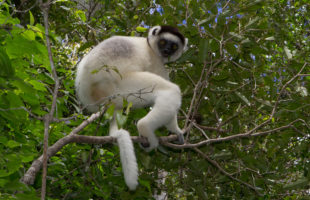Zombitse-Vohibasia: The compounded name of this national park derives from two of three areas belonging to the park. Zombitse means as much as „dense forest“ and thus names the dry forest of the national park. Vohibasia is the savannah in front of this forest and means „hill of pistols“, which is attributed to conflicts between the people of the South …
LesenMasika sipa
The seal
Madagascar’s current seal was designed in 1993 and has been in use in this form throughout. It shows the outlines of the country in red color within a white circle, below is a stylized zebu head on an equally stylized rice field. The silhouette of the country is framed by the leaves of the travellers’ tree. The zebu and the …
LesenFrom bean to spice – vanilla
The vanilla plant is actually an orchid and has been successfully cultivated in Madagascar for over a century. Although originally from Central America, Madagascar is now the world’s largest exporter of vanilla. But it will be a long way before the “queen of spices” lands in Europe. Vanilla grows particularly well wherever it is warm and very humid. Their tendrils …
LesenThe angels of the forest: Silky sifakas
The Silky Sifaka (Propithecus candidus) is one of the most beautiful and special lemurs of Madagascar, but also one of the rarest. There are only about 250 sexually mature silk sifakas left in Madagascar, otherwise they do not occur anywhere else in the world. For comparison: In Asia alone there are still around 3000 to 5000 full-grown specimens of tigers …
LesenThe Tree of Travelers
The Ravenala, better known as the tree of travelers, belongs to the strelitzia family, despite resembling a palm tree. Although it is now common all over the world and is even cultivated as an ornamental plant in some homes, it originated in Madagascar and only occurs naturally there. Ravenalas grow from six to thirty meters and are particularly known for …
LesenDarwin’s orchid
As early as 1802, French colonialists in Madagascar discovered a unique, white-flowering orchid whose waxy blossom had a diameter of a good 12 cm. They had never seen anything like it, and so it was also a Frenchman named Du Petit-Thouars, who 20 years later wrote down a description of the peculiar flower for the first time. He called it …
LesenBaobab Avenue
The legendary Baobab Avenue is located on the road (or let’s better say the dusty slope) between Morondava and Belo sur Tsiribinha in west Madagascar. It is in the province of Menabe. Everywhere along the road between those two cities, you can find the impressive Baobab trees, only a small part of 250 meters length is known as Baobab Avenue …
LesenThe rarest lemur on Earth: Perrier’s Sifaka
Practically the counterpart to the white Silky Sifaka is the closely related Black Sifaka or Perrier’s Sifaka (Propithecus perrieri). With a height of 85 to 92 cm and a weight of three to six kilograms, it belongs to the larger lemurs, with the tail accounting for up to 46 cm of its total length. Suitably to the name these animals …
LesenMasoala national park
Masoala: Masoala means “eyes of the forest”. The national park owes this name to the Aye-Aye (Daubentonia madagascariensis), whose eyes ghostly glow like two large yellow spheres in the light cone of the torch at night. Unfortunately, night walks in national parks are currently forbidden, so that only the name testifies to this magnificent experience. Location: The Masola National Park …
LesenSecret kings of the North: Golden crowned sifakas
In an incredibly hot, dry and inaccessible area in north-eastern Madagascar live white lemurs, which owe their name to the golden fur on their heads: the Golden Crowned Sifakas (Propithecus tattersalli). The secret kings of the north reach a height of just 95 cm with a weight of 3.5 kg, whereby still further 45 cm of tail come in addition. …
Lesen MADAMAGAZINE Your Magazine about Madagascar
MADAMAGAZINE Your Magazine about Madagascar










